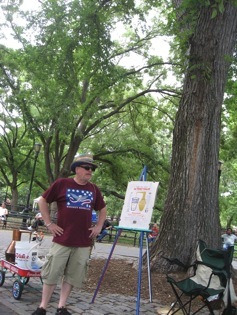Tompkins Square
















23rd Anniversary of the 1986 Tompkins Square Police Riot
& text from May Day 2011
text from the Society’s 2011 May Day announcement
TOMPKINS SQUARE
In the 19th & 20th Centuries, May Day became a celebration of International Workers’ Rights. Tompkins Square has a long history of radical movements and May Day riots and celebrations. The January 13, 1874 Tompkins Square Riot was of particular significance. The riot occurred in the park when police crushed a demonstration involving thousands of workers. This Tompkins Square riot marked the beginning of an unprecedented era of labor conflict and violence.
The violence of late 19th & early 20th Century was initiated by police and private contractors who were working for the Robber Barons and their cronies. The violence was directed against workers asking for a living wage. Today we are again struggling for worker rights and a living wage, please reference Unions Madison Wisconsin.
The giant ELM TREES in Tompkins Square provides the area a canopy of twisted and knurly branches. Elm trees are now rare because of Dutch elm disease but Tompkins Square still has a large grove of elms that have survived. The elm tree was important to Native Americans who did not build churches; in place of man made structures they met under sacred trees. This was also true of the Celtic Druids. To the Celts, oak trees were sacred; to many Native Americans, the elm tree was a sacred meeting place. Below we explain how Tamanend and the Lenni-Lenape nation met with the leaders of the Pennsylvania colony under a large elm tree at Shakamaxon [great name, say it out loud] in the early 1680s.
It should also be noted that the original Boston Commons was centered around a giant elm tree. Deacon Elliot’s Conner, as the Commons was then know, was well know for the sight of the great elm tree and as a meeting place and market. Later, after the Stamp Act riots, the Great Elm became know as the Liberty Tree.
THE ORIGINAL AMERICAN MAY DAY
Though the arrival of spring is universally celebrated, Europe’s May Day has its origins in the Celtic festival of Beltane. In the English colonies of North America, the people’s celebration of May Day shifted its focus to honor Saint Tamanend.
Tamanend was one of the Native American leaders of the Lenni-Lenape nation. They met with the leaders of the Pennsylvania colony under a large elm tree at Shakamaxon in the early 1680s. There, Tamanend announced that the Lenni-Lenape and the English colonists would "live in peace as long as the waters run in the rivers and creeks and as long as the stars and moon endure." These words have been memorialized on the statue of Tamanend that stands today in Philadelphia, though we don’t believe that there are many Lenni-Lenape with us now.
This vision of peace and harmony is why Tamanend was America’s first secular humanist saint; there would later be many variations of both his name and the societies that he inspired. One of the later attributions was the Sons of St. Tammany, an organization of rank and file enlisted veterans of the American Revolution with overlapping membership with the Daughters and Sons of Liberty. The Sons of St. Tammany were also closely linked to the Democratic Clubs across America, who were in direct communications with the French Jacobins. In New York city, Tamanend’s heirs united in 1786 and incorporated on May 12, 1789 as the Tammany Society, later they built Tammany Hall.
The American army at Valley Forge celebrated St. Tamanend Day on the first day of May. After the war St. Tamanend Day was celebrated throughout the states and territories with reports of George Washington and Patrick Henry traveling together to observe its celebration in Richmond, Virginia.
There is a direct connection between Daughters & Sons of Liberty and the Sons of St. Tammany. The Daughters and Sons of Liberty started in Boston in early summer of 1765 as a group of shopkeepers and artisans. The origins of the American Revolution were with these working class heroes, not with the Virginia planters or the northern merchants. They were the true radicals of the American Revolution. In addition to starting the Tammany Society after the war, the Daughters & Sons of Liberty would also instigate Shays Rebellion and the Whiskey Rebellion. In New York City, the Tammany Society chose Aaron Burr as their political representative.
Today, as unions and immigrants march with other progressive people on May Day, we should remember Tamanend, the Daughters and Sons of Liberty and the original Tammany Societies.

Its always good to go back to Tompkins Square.
Chris Flash of the Shadow invited us to display our whiskey still and talk about the 2nd Whiskey Rebellion at their yearly Riot celebration. So on August 6, 2011 we set up our still and the letterpress poster under the park’s Great Elm tree. We then communed with the other elm trees as well as our brothers and sisters both on and off the stage. As our reward there was classic and contemporary Punk protest music.
The shock waves from the ‘86 Riot and ensuing confrontations and mini riots reverberated into the early 1990s. Today those rebellious spirits were distilled and amplified through the music, speakers and our own strategically placed still. The highlight of the afternoon was David Peel’s performance of Die Yuppie Scum and Up Against the Wall Motherfuckers, true classics.
Our most dedicated members will remember the posting from May Day 2011, which was about the park’s radical history and the park’s ancient grove of Elm trees. It went on to explain the importance of large, old trees as sacred meeting places for Native Americans and Celtic Druids. The posting also had a history of radical American May Days celebrations under great Elm trees, going back before the Revolution.
But rest assured pilgrims, that text is bellow.
